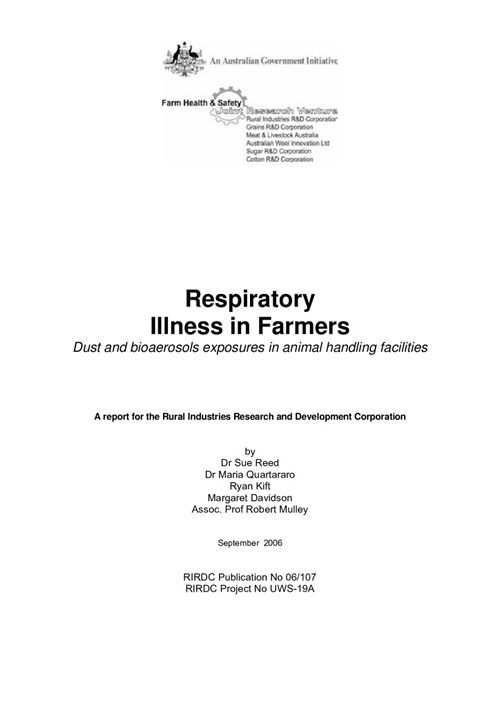Non-intentional Farm-Related Incidents in Australia 2021
AgHealth Australia has been leading research into deaths and injuries on farm since 2004, providing the most comprehensive evidence on which to build prevention approaches...

183 pages
Published: 19 Sep 2006
Author(s): Reed, S., Dr, Quartararo, M, Dr, Kift, R., M. Davidson,, M. Davidson,
Download report PDF
DownloadPurchase a hard copy - AUD $75.00
Occupational health and safety issues have become a major issue in Australia and all employers are required to determine whether farm environments have the potential to adversely impact on the health of their workers. The aim of this study was to review the literature to determine what is known about the potential exposure to dust and bioaerosols and the potential impact on the respiratory health of workers in animal handling facilities in an agricultural setting. The aims of the study were to identify the concentrations of dusts and bioaerosols to which people working in animal production are currently exposed and determine which animal production systems have the potential to be a risk to worker health.
The report reviews more than 250 Australian and international papers and reports on the topic. This literature acknowledged that farm workers may experience respiratory symptoms as a consequence of working in these conditions. The link between the often dusty work environment of animal husbandry workers and its adverse impact on health on is not as well defined as was expected, as very few international airborne dust and bioaerosol exposure studies have been adequately linked to epidemiological studies and none in Australia. Consequently more in-depth work on this topic needs to be undertaken in Australia.
The importance of this report is that it provides basic statistical information on the impact of dust and bioareosols on farm workers employed in the pig, poultry, cattle, sheep, horse and deer industries. It is primarily targeted at occupational health and safety and environmental health practitioners who may need to advise farm owners/managers in Australia on the potential respiratory risks for their workers from exposure to dusts and bioaerosols. Investors in these animal industries may use the report as a basis from which to make decisions about controlling dust and bioaerosols in enclosed animal housing. The report will also be useful to medical practitioners whose patients may be employed in animal handling facilities and presenting respiratory symptoms that may be a result of their work. The report will also inform policy development, and will help RIRDC as it plans its research and development priorities into the future.
The report has identified that more detailed studies on the impact of exposure to dust and bioaerosols on the health of agricultural workers need to be undertaken in Australia.